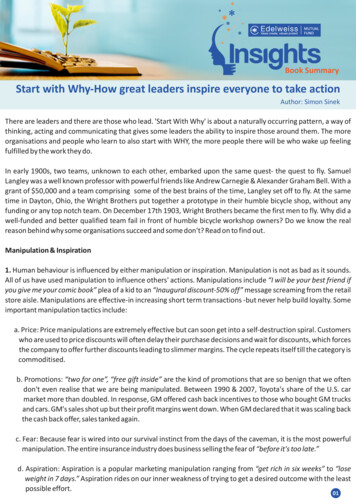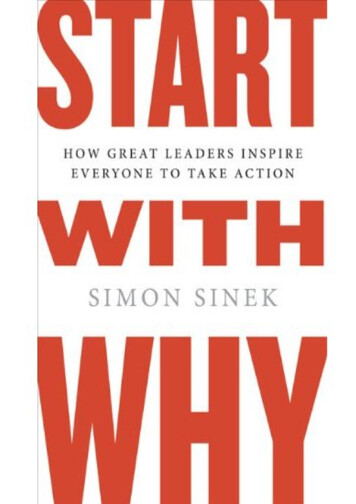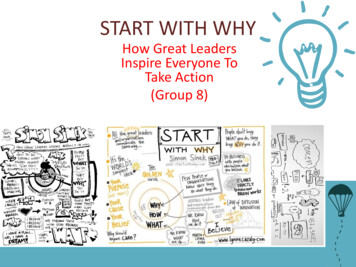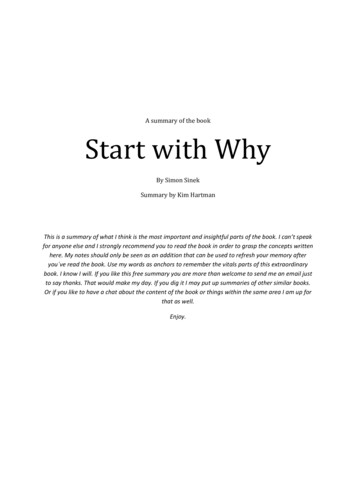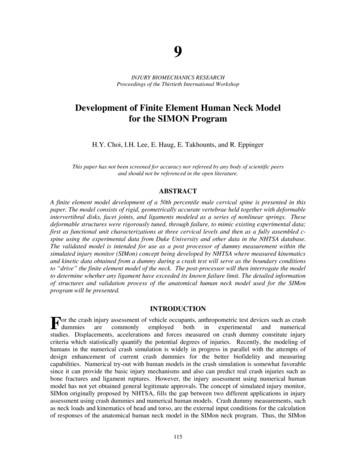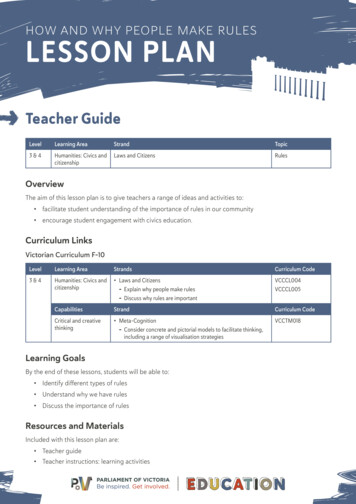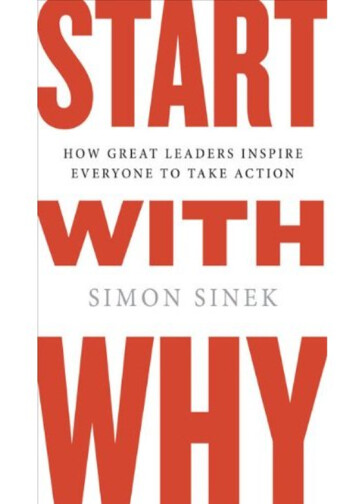
Transcription
START WITH WHY
STARTWITH WHYHOW GREAT LEAD ERSINSPIR E EVERYONETO TA KE ACTIONSIMO N S I NE KPORTFOLIO
PORTFOLIOPublished by the Penguin GroupPenguin Group (USA) Inc., 375 Hudson Street, New York, New York 10014, U.S.A.Penguin Group (Canada), 90 Eglinton Avenue East, Suite 700, Toronto, Ontario,Canada M4P 2Y3 (a division of Pearson Penguin Canada Inc.)Penguin Books Ltd, 80 Strand, London WC2R 0RL, EnglandPenguin Ireland, 25 St. Stephen’s Green, Dublin 2, Ireland (a division of Penguin Books Ltd)Penguin Books Australia Ltd, 250 Camberwell Road, Camberwell,Victoria 3124, Australia (a division of Pearson Australia Group Pty Ltd)Penguin Books India Pvt Ltd, 11 Community Centre, Panchsheel Park, New Delhi – 110 017, IndiaPenguin Group (NZ), 67 Apollo Drive, Rosedale, North Shore 0632,New Zealand (a division of Pearson New Zealand Ltd)Penguin Books (South Africa) (Pty) Ltd, 24 Sturdee Avenue,Rosebank, Johannesburg 2196, South AfricaPenguin Books Ltd, Registered Offices: 80 Strand, London WC2R 0RL, EnglandFirst published in 2009 by Portfolio,a member of Penguin Group (USA) Inc.1 3 5 7 9 10 8 6 4 2Copyright Simon Sinek, 2009All rights reserved“The Sneetches” from The Sneetches and Other Storiesby Dr. Seuss. Trademark TM andcopyright by Dr. Seuss Enterprises, L.P. 1953, 1954, 1961, renewed 1989. All rights reserved.Used by permission of Random House Children’sBooks, a division of Random House, Inc. andInternational Creative Management, Inc., agents for Dr. Seuss Enterprises, L.P.L I B R A R Y O F C O N G R E S S C ATA L O G I N G - I N - P U B L I C AT I O N D ATASinek, Simon.Start with why : how great leaders inspire everyone to take action / by Simon Sinek.p. cm.Includes bibliographical references and index.ISBN 978-1-59184-280-41. Leadership. I. Title.HD57.7.S549 2009658.4’092—dc222009021862Printed in the United States of AmericaSet in MinionDesigned by Victoria HartmanWithout limiting the rights under copyright reserved above, no part of this publication may bereproduced, stored in or introduced into a retrieval system, or transmitted, in any form or by anymeans (electronic, mechanical, photocopying, recording or otherwise), without the prior writtenpermission of both the copyright owner and the above publisher of this book.The scanning, uploading, and distribution of this book via the Internet or via any other meanswithout the permission of the publisher is illegal and punishable by law. Please purchase onlyauthorized electronic editions and do not participate in or encourage electronic piracy ofcopyrightable materials. Your support of the author’s rights is appreciated.While the author has made every effort to provide accurate telephone numbers and Internet addressesat the time of publication, neither the publisher northe author assumes any responsibility for errors,or for changes that occur after publication. Further, publisher does not have any control over anddoes not assume any responsibility for author or third-party Web sites or their content.
For Victoria,who finds good ideasand makes them great
There are leaders and there are those who lead.Leaders hold a position of power or infl uence.Those who lead inspire us.Whether individuals or organizations, we follow thosewho lead not because we have to, but because we want to.We follow those who lead not for them, but for ourselves.This is a book for those who want to inspire others andfor those who want to fi nd someone to inspire them.
CONTENTSIntroduction:Why Start with Why?1PART 1: A WORLD THAT DOESN’T START WITH WHY1. Assume You Know2. Carrots and Sticks1116PART 2: AN ALTERNATIVE PERSPECTIVE3. The Golden Circle4. This Is Not Opinion, This Is Biology5. Clarity, Discipline and Consistency375265PART 3: LEADERS NEED A FOLLOWING6. The Emergence of Trust7. How a Tipping Point Tips83115PART 4: HOW TO RALLY THOSE WHO BELIEVE8. Start with WHY, but Know HOW9. Know WHY. Know HOW. Then WHAT?10. C ommuni cati on I s N ot About Speaki ng,It’s About Listening133154160
x /ContentsPART 5: THE BIGGEST CHALLENGE IS SUCCESS11. When WHY Goes Fuzzy12. Split Happens175183PART 6: DISCOVER WHY13. The Origins of a WHY14. The New 1
INTRODUCTIONWHY START WITH WHY?This book is about a naturally occurring pattern, a way of thinking,acting and communicating that gives some leaders the ability toinspire those around them. Although these “natural-born leaders”may have come into the world with a predisposition to inspire, theability is not reserved for them exclusively. We can all learn thispattern. With a little discipline, any leader or organization can inspire others, both inside and outside their organization, to helpadvance their ideas and their vision. We can all learn to lead.The goal of this book is not simply to try to fix the things thataren’t working. Rather, I wrote this book as a guide to focus on andamplify the things that do work. I do not aim to upset the solutionsoffered by others. Most of the answers we get, when based on soundevidence, are perfectly valid. However, if we’re starting with thewrong questions, if we don’t understand the cause, then even theright answers will always steer us wrong . . . eventually. The truth,you see, is always revealed . . . eventually.The stories that follow are of those individuals and organizations that naturally embody this pattern. They are the ones thatstart with Why.
2/S TA RT W IT H W H Y1.The goal was ambitious. Public interest was high. Experts wereeager to contribute. Money was readily available.Armed with every ingredient for success, Samuel PierpontL angley set out i n the ear ly 1900s to be the first man to pilot anairplane. Highly regarded, he was a senior officer at the Smithsonian Institution, a mathematics professor who had also worked atHarvard. His friends included some of the most powerful men ingovernment and business, including Andrew Carnegie and Alexander Graham Bell. Langley was given a 50,000 grant from the WarDepartment to fund his project, a tremendous amount of moneyfor the time. He pulled together the best minds of the day, a veritable dream team of talent and know-how. Langley and his teamused the finest materials, and the press followed him everywhere.People all over the country were riveted to the story, waiting to readthat he had achieved his goal. With the team he had gathered andample resources, his success was guaranteed.Or was it?A few hundred miles away, Wilbur and Orville Wright wereworking on their own flying machine. Their passion to fly was sointense that it inspired the enthusiasm and commitment of a dedicated group in their hometown of Dayton, Ohio. There was nofunding for their venture. No government grants. No high-levelconnections. Not a single person on the team had an advanceddegree or even a college education, not even Wilbur or Orville. Butthe team banded together in a humble bicycle shop and made theirvision real. On December 17, 1903, a small group witnessed a mantake flight for the fi rst time in history.How did the Wright brothers succeed where a better-equipped,better-funded and better-educated team could not?It wasn’t luck. Both the Wright brothers and Langley were highlymotivated. Both had a strong work ethic. Both had keen scientificminds. They were pursuing exactly the same goal, but only theWright brothers were able to inspire those around them and truly
W HY S TART W IT H W HY ?/3lead their team to develop a technology that would change theworld. Only the Wright brothers started with Why.2.In 1965, students on the campus of the University of California,Berkeley, were the first to publicly burn their draft cards to protestAmerica’s involvement in the Vietnam War. Northern Californiawas a hotbed of antigovernment and antiestablishment sentiment;footage of clashes and riots in Berkeley and Oakland was beamedaround the globe, fueling sympathetic movements across theUnited States and Europe. But it wasn’t until 1976, nearly threeyears after the end of America’s military involvement in the Vietnam conflict, that a different revolution ignited.They aimed to make an impact, a very big impact, even challenge the way people perceived how the world worked. But theseyoung revolutionaries did not throw stones or take up arms againstan authoritarian regime. Instead, they decided to beat the systemat its own game. For Steve Wozniak and Steve Jobs, the cofoundersof Apple Computer, the battlefi eld was business and the weapon ofchoice was the personal computer.The personal computer revolution was beginning to brew whenWozniak built the Apple I. Just starting to gain attention, the technology was primarily seen as a tool for business. Computers weretoo complicated and out of the price range of the average individual. But Wozniak, a man not motivated by money, envisioned anobler purpose for the technology. He saw the personal computeras a way for the little man to take on a corporation. If he couldfigure out a way to get it in the hands of the individual, he thought,the computer would give nearly anyone the ability to perform manyof the same functions as a vastly better resourced company. Thepersonal computer could level the playing field and change the waythe world operated. Woz designed the Apple I, and improved thetechnology with the Apple II, to be affordable and simple to use.No matter how visionary or how brilliant, a great idea or a great
4/S TA RT W IT H W HYproduct isn’t worth much if no one buys it. Wozniak’s best friendat the time, the twenty-one-year-old Steve Jobs, knew exactly whatto do. Though he had experience selling surplus electronics parts,Jobs would prove to be much more than a good salesman. Hewanted to do something signifi cant in the world, and building acompany was how he was going to do it. Apple was the tool he usedto ignite his revolution.In their fi rst year in business, with only one product, Applemade a million dollars in revenues. By year two, they did 10 million in sales. In their fourth year they sold 100 million worth ofcomputers. And in just six years, Apple Computer was a billiondollar company with over 3,000 employees.Jobs and Woz were not the only people taking part in the personal computer revolution. They weren’t the only smart guys in thebusiness; in fact, they didn’t know much about business at all. Whatmade Apple special was not their ability to build such a fast-growthcompany. It wasn’t their ability to think differently about personalcomputers. What has made Apple special is that they’ve been ableto repeat the pattern over and over and over. Unlike any of theircompetitors, Apple has successfully challenged conventional thinking within the computer industry, the small electronics industry,the music industry, the mobile phone industry and the broaderentertainment industry. And the reason is simple. Apple inspires.Apple starts with Why.3.He was not perfect. He had his complexities. He was not the onlyone who suffered in a pre–civil rights America, and there wereplenty of other charismatic speakers. But Martin Luther King Jr.had a gift. He knew how to inspire people.Dr. King knew that if the civil rights movement was to succeed,if there was to be a real, lasting change, it would take more thanhim and his closest allies. It would take more than rousing wordsand eloquent speeches. It would take people, tens of thousands of
W HY S TART W IT H W HY ?/5average citizens, united by a single vision, to change the country. At11:00 a.m. on August 28, 1963, they would send a message to Washington that it was time for America to steer a new course.The organizers of the civil rights movement did not send outthousands of invitations, nor was there a Web site to check the date.But the people came. And they kept coming and coming. All told,a quarter of a million people descended on the nation’s capital intime to hear the words immortalized by history, delivered by theman who would lead a movement that would change America forever: “I have a dream.”The ability to attract so many people from across the country,of all colors and races, to join together on the right day, at the righttime, took something special. Though others knew what had tochange in America to bring about civil rights for all, it was MartinLuther King who was able to inspire a country to change not justfor the good of a minority, but for the good of everyone. MartinLuther King started with Why. There are leaders and there are those who lead. With only 6 percentmarket share in the United States and about 3 percent worldwide,Apple is not a leading manufacturer of home computers. Yet thecompany leads the computer industry and is now a leader in otherindustries as well. Martin Luther King’s experiences were notunique, yet he inspired a nation to change. The Wright brotherswere not the strongest contenders in the race to take the firstmanned, powered fl ight, but they led us into a new era of aviationand, in doing so, completely changed the world we live in.Their goals were not different than anyone else’s, and their systems and processes were easily replicated. Yet the Wright brothers,Apple and Martin Luther King stand out among their peers. Theystand apart from the norm and their impact is not easily copied.They are members of a very select group of leaders who do something very, very special. They inspire us.Just about every person or organization needs to motivate
6/S TA RT W IT H W H Yother s to act for some reason or another. Some want to motivatea purchase decision. Others are looking for support or a vote.Still others are keen to motivate the people around them to workharder or smarter or just follow the rules. The ability to motivatepeople is not, in itself, difficult. It is usually tied to some externalfactor. Tempting incentives or the threat of punishment will oftenelicit the behavior we desire. General Motors, for example, so successfully motivated people to buy their products that they soldmore cars than any other automaker in the world for over seventyseven years. Though they were leaders in their industry, they didnot lead.Great leaders, in contrast, are able to inspire people to act. Thosewho are able to inspire give people a sense of purpose or belongingthat has little to do with any external incentive or benefi t to begained. Those who truly lead are able to create a following of people who act not because they were swayed, but because they wereinspired. For those who are inspired, the motivation to act is deeplypersonal. They are less likely to be swayed by incentives. Those whoare inspired are willing to pay a premium or endure inconvenience,even personal suffering. Those who are able to inspire will create afollowing of people—supporters, voters, customers, workers—whoact for the good of the whole not because they have to, but becausethey want to.Though relatively few in number, the organizations and leaderswith the natural ability to inspire us come in all shapes and sizes.They can be found in both the public and private sectors. They arein all sorts of industries—selling to consumers or to other businesses. Regardless of where they exist, they all have a disproportionate amount of influence in their industries. They have the mostloyal customers and the most loyal employees. They tend to bemore profitable than others in their industry. They are more innovative, and most importantly, they are able to sustain all thesethings over the long term. Many of them change industries. Someof them even change the world.The Wright brothers, Apple and Dr. King are just three exam-
W HY S TART W IT H W HY ?/7ples. Harley-Davidson, Disney and Southwest Airlines are threemore. John F. Kennedy and Ronald Reagan were also able to inspire. No matter from where they hail, they all have something incommon. All the inspiring leaders and companies, regardless ofsize or industry, think, act and communicate exactly alike.And it’s the complete opposite of everyone else.What if we could all learn to think, act and communicate likethose who inspire? I imagine a world in which the ability to inspireis practiced not just by a chosen few, but by the majority. Studiesshow that over 80 percent of Americans do not have their dreamjob. If more knew how to build organizations that inspire, we couldlive in a world in which that statistic was the reverse—a world inwhich over 80 percent of people loved their jobs. People who lovegoing to work are more productive and more creative. They gohome happier and have happier families. They treat their colleaguesand clients and customers better. Inspired employees make forstronger companies and stronger economies. That is why I wrotethis book. I hope to inspire others to do the things that inspirethem so that together we may build the companies, the economyand a world in which trust and loyalty are the norm and not theexception. This book is not designed to tell you what to do or howto do it. Its goal is not to give you a course of action. Its goal is tooffer you thecauseof action.For those who have an open mind for new ideas, who seek tocreate long-lasting success and who believe that your success requires the aid of others, I offer you a challenge. From now on, startwith Why.
Sinek, Simon. Start with why : how great leaders inspire everyone to take action / by Simon Sinek. p. cm. Includes bibliographical references and index. ISBN 978-1-59184-280-4 1. Leadership. I. Title. HD57.7.S549 2009 658.4'092—dc22 2009021862 Printed in the United States of America Set in Minion Designed by Victoria Hartman
